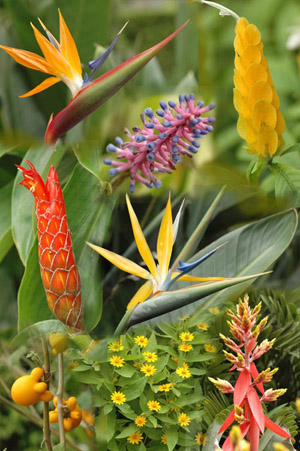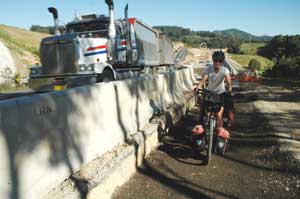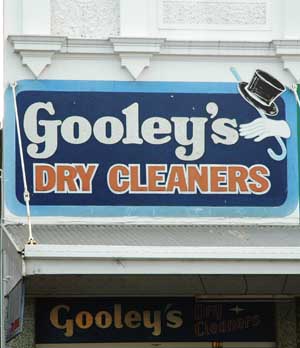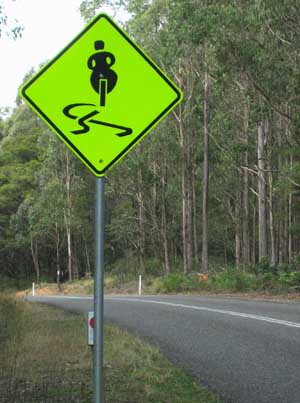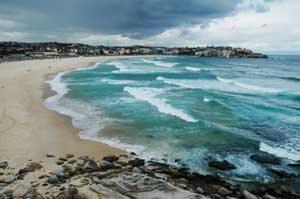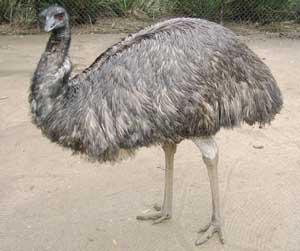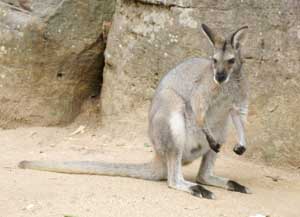Australia
|
 |
|||
Country Summary |
||||
|---|---|---|---|---|
We arrived in Brisbane in late April 2006 and took a bit less than one month cycling to Sydney (see our statistics below). We mainly cycle inland in Southern Queensland and New England. We only touched the coast at Byron Bay and from Newcastle to Sydney.
|
||||
|
Australia - The trees, the birds, the language, the weather and the people are all bright, bold and brash |
|||
|
|
|||
|
No nasty bites, no allergies, no nothing. But it doesn't stop one worrying about what lies inside your shoe, sleeping bag or under the toilet seat! |
|||
|
|
|||
|
27th to 30th of April 2006 - Brisbane - 29 km Brisbane is quite cycle friendly and we have used our bikes a lot around the city. There are very pleasant cycle paths along the river but unfortunately none from the airport, which was a short but rather nasty ride. Brisbane is a modern city, high rise and definitely cosmopolitan. Asian people seem to make most of the foreign population living here. It is a busy city, but there are many places to relax along the river banks and in the many parks that dot the city. What really impresses us is the amount of wildlife to be found in the very heart of the city, from loud strange birds to mangrove trees. |
Arrival in central Brisbane, next to the Brisbane river |
||
China and Europe combine in the chinatown valley area of central Brisbane
|
The area around the wonderful Roma Park in Brisbane
|
|||
One of the many areas reclaimed from the sea in the Gold Coast south of Brisbane - now used for "Lifestyle" properties
|
||||
1st to 3rd May 2006 - Brisbane to Lamington National Park - 184 km Our first day driving out of Brisbane started with a great climb to Mt Coo-tha. The views out on to Brisbane, Moreton Island and the Ocean were great. Below us was another of Brisbane's botanical gardens, where we spotted our first snake, looking all angry and standing up. "Just a tree snake" said a guy walking past "I have lots in my garden". Well, what kind of snake will get an Ozzie startled and moving back? We were left to ponder. The ride to Ipswich was rolly, against the wind and mainly along big roads. We only did 50 km but climbed 1000m to get away from Brisbane. We recovered in one of Ipswich parks (there is no campsite here) amongst huge ants, broken bottles and the odd, used syringe (all the public toilets around the Brisbane area have syringe disposal facilities).
|
Mount Coo-Tha and the view back down to Brisbane |
|||
The next two days were much more scenic as we headed South towards the Lamington mountains. We rode towards the town of Beaudesert, then into the mountains along small one-lane country roads, which we had forgotten all about in New Zealand. The city traffic was replaced by campervans and south of Beaudesert, we had the road to ourselves. This is because we were heading towards our first bit of off-road leading to the top of the mountains. The Duck Creek road is a DIY road, built from 1978 to 1988 to link the Kerry Valley with O Reillys in Lamington NP. It is a beautiful road climbing steeply about 800m on gravel from green valleys of sparse eucalyptus low down to the dense vine rainforest higher up. Hard, tiring and sweaty work but well worth it.
|
There are distinct disadvantages to all the fresh fruit available in Australia
|
|||
Golden Orb Spiders hang from the spaces between the trees - their webs can be 3 metres in diameter - the spider is about 2 inches across
|
The road from Ipswich to Beaudesert - much quieter compared to Brisbane, great views, lovely temperature - the cycle touring was starting to look up again
|
|||
|
But let's go back to the town of Beaudesert, which is neither "beau" or "desert". Terry set off on a troll to look for his evening beer fix and instead walked into a trail of discovery. He was walking from the caravan park back into town. The first problem he encountered was the lack of pavement. There are none apart in the very middle of the town. No wonder that he was the only one walking around. He then went in the bottle store and was asked what he was doing there. " I want booooze" said he dribbling, lust shining in his wicked eyes. "You cannot have it here, you must go out and queue with the cars". You guessed it, Terry went to a drive through bottle store, which really does not deal with non-motorised customers. So here he was, standing in line between two cars (when wanting beer, he has no shame). |
|||
And a few more details crossed his eyes on this evening. He noticed a board reminded us that we had missed "Secretaries and office professionals Day" on May 18th. This must fill a gap in the greeting cards sales in May. And how about the name tag people wear in shops. Are they real or made up? So far we have spotted Samanther, Annya, Maree, Laraine and Christabelle (for some reason they are always female). (right) Unfortunately $2 worth was too heavy to carry on the bikes |
|
|||
A queenslander style house |
4th to 5th May 2006 - Twitching in Lamington National Park We stopped for two days at O'Reillys in the heart of the National Park (good room deal in the low season). We spent two days walking around the amazing rainforest and spotting a scores of new birds, from the brush turkeys to wonderful colourful parrots. Here we found our favourite forest walk, winding our way up the mountains, crossing streams and passing a dozen beautiful waterfalls. The park is on the edge of an old volcano, something like 200 millions year old. Its chimney remains as imposing Mt Warning, the first place in Australia to see the morning sun. |
|||
The climb up to Lamington Park was a stinker!
|
View from Queensland into the "Lost World" in New South Wales from the Lamington Plateau |
|||
6th to 8th May 2006 - Lamington National Park to Byron Bay - 217 km We wiggled our way in between Lamington and Springbrook national parks. The scenery was amazing - we were cycling amongst lush green fields on top of hills with views out towards the ocean and the big tower blocks of Surfer Paradise on the coast. After 90 km, we stopped at a picnic area for the night and realised that as the crow flies we were no more than 6km further from where we started!
The sun can be so hot that the cows ears droop - or the cows are interbred with rabbits |
We are constantly stopping to make wild guesses as to what the unknown plant life alongside the road may be called
|
|||
Rainforest and waterfalls in Lamington National Park - favourite walk of the trip!
|
The ride down from Lamington - nearly 33km downhill
|
|||
Natural bridge falls National Park
|
The following day, we rode up the Numinbah valley and then down towards Murwillumbah, crossing the boundary of Queensland into New South Wales and into the old volcanic caldera of Mt Warning. The Numinbah valley is wedged between impressive cliffs and crosses many pleasant villages. Up to Murwillumbah, everything is still very green and flowery. There are plenty of stalls selling all kinds of home grown fruits and vegs. Around Murwillumbah, the flat fields are full of sugar cane. It was not the picture we had of Australia at all. We cannot help noticing some weird spelling along our way. For instance: "rejevenisation" and "avocadoes". Isa fears her English, which has suffered much in China, will take another knock. |
|||
We then headed towards the coast and rode South from Cabarita to Byron Bay. This was not such a lovely route because it is impossible to completely avoid Highway no1. The ride was in part fairly pleasant, between the sea (which you cannot see) and the forest, but the section of motorway we followed was awful. There was a cycle lane on the side, but the motorway was being widened, so the lane was in places taken over by the building site. Off we were in the midst of the fast traffic, road trains and thundering semis. In addition, the road was really hilly and the wind strongly blowing against us. We were happy to reach the little haven of Byron Bay, but our mind was now definitely set onto going inland rather than following the coast down to Sydney.
Roadworks, 2 lanes and scary big semis and b doubles on the Pacific Highway - very unpleasant! |
Care should be taken on all rural Australian roads - a Koala can make a mess of a bicycles front wheel. Some roads even have a "Koalas Killed" count comparing performance year by year |
|||
Crimson Rosella
|
We chose to avoid the Gold Coast, on our descent from Beechmont we were glad to see our decision was justified
|
|||
9th and 10th May - Relaxing in Byron Bay Byron Bay is some kind of Mecca for the ones who travel the East coast. It is a strange blend of surfer dudes, tourists, retired people, eccentrics, psychics and hippies. Despite Terry's first wariness of all things hippy, the place grew on us. The beaches are fantastic, there are some good waves and some excellent snorkeling spots. We took a not so deserved two days off simply relaxing here. 11th to 13th May 2006 - Byron Bay to Lowana - 312 km The road inland started climbing straight after Byron Bay and gave us beautiful views back onto Cape Byron and the Pacific ocean. It was pretty hilly until the town of Lismore. From then on through Casino and then towards the South, the road was gently undulating through Eucalyptus , pine forest and cattle country. This used to be called the "big bush" and stretched up to Byron Bay. Red cedars, tallowoods and many other tropical trees used to thrive. They were all logged to death and the remnant of the forest cleared before the end of the 19th century.
|
Terry and friend on Byron Bay beach |
|||
The landscape opened and became more interesting when we reached the immense Clarence river and followed it from Lawrence to Grafton. A flock of Pelicans was loudly arguing about fish guts being thrown into the river by some fishermen. Looking at the scene, we could not help noticing the board next to the local gutting spot. It stated that "if any octopus, great Queensland grouper or great white shark is caught, put them carefully back into the water". This is if you can keep your cool while lifting your net out of the water!
Great for cycling - a gravel road with no semis or B-doubles (Trucks)
|
Sun and calm waters of the River Clarence - before we knew it we had both fallen asleep in the comfortable quiet picnic area
|
|||
Pelicans on the River Clarence - at 1.8m in height they are huge birds
|
||||
This type of road was all but impossible to find in New Zealand. Australia is packed full of tiny, narrow roads with hosts of choices and alternative routes for cycle tourists. |
We went to Grafton hoping to see the fruit bats, also known as flying foxes. They are huge, about one meter wingspan, and can be see flying in flocks above the river. But we overlooked the fact that they are nomadic bats and come to Grafton in the summer only. Doooh! Now, there is a funny thing about cities and towns in Australia. In New Zealand, they scratch their heads very hard to come up with cheerful and bewildering little mottos like "Richmond - It's all good!" or "Nelson - live the day!". Maybe the Ozzies lack imagination in this department because many towns and cities modestly pride themselves in being "tidy". Grafton, for instance, proudly advertise its status of "most tidy" city in 1993.
|
|||
The centre of Dorrigo, a very pleasant place with waterfalls, rainforest parks and fabulous sunsets |
On the way up to the tablelands from Dorrigo - has autumn caught up with us, again?
|
|||
After Grafton, we carried on South following a hilly road and through some pretty villages, also self-qualified as "tidy" by the local boards. The local fruits and vegs stalls were still here, but we were out of the juicy tropical fruits zone to Isa's great disappointment. Marrows seem to be the easy vegetable to grow - they are everywhere but they are not the most handy or lightest vegetable when cyclotouring. At the village of Coramba, we started a long climb towards the top of the New England tablelands. 600 metres climb before setting up camp, exhausted, in a corner of the rainforest. |
An inquisitive visitor to the inside of our tent |
|||
Sunset at one of the excellent Australian lookouts |
14th May to 17th May 2006 - Lowana to Uralla - 235km on the New England tablelands We met a villager from the tiny village of Oolong on our first morning on the New England tablelands. "You've done all the climbing. It's all flat from here " he said before showing us onto the gravel road to Dorrigo. Before coming back on the man's comment, let's marvel at the 26km of gravel road that meanders through the rainforest between Lowana and Dorrigo. It is beautiful and hardly used by motorised vehicles - highly recommended if you cycle around the area (take the southern gravel track). We also had a nice insight into some other forms of wildlife. We spotted a python and a red-bellied black snake, three meters long with a potentially fatal bite. But thankfully for us (not for them) both were dead and flat by the side of the road. |
|||
Dorrigo is a lovely small town, of the tidy type again. It has the advantage of being set in the midst of five major national parks, and some more if you count the smaller parks. Five different types of rainforest can be accessed within an hours drive by car. But despite all the surrounding wilderness, the landscape around the town has a definite English touch despite the lone eucalyptus trees and the red earth. Cows were peacefully grazing on the green grass in the enclosed rolling fields and gentle rain forest topped hills stretch for miles around. |
Our luck with the weather changed when we headed from Dorrigo up to the tablelands - New England was living up to its name |
|||
One part of the 2 stage Ebor falls
|
On leaving Dorrigo, we found out that the hills were not gentle at all. This was one of our hardest day cycling in Oz. To complement the English looking landscape, a persistent and annoying drizzle settled on us, followed very closely by thick banks of fog. We were suddenly cycling in the heart of winter. The temperature dropped to 9dC and with the low visibility it really did feel like we were back to England if it was not for the parakeets flying through the fog from time to time. This was the "Waterfall way" section of our ride. The fog threatened to spoil the whole experience, but it did lift out a little to make us have a look on the magnificent Ebor falls. Then we were back cycling in the drizzle up to Cathedral rocks national park. The moral was pretty low, as it infallibly happens after a wet day cycling. But on approaching our campsite, we spotted our first kangaroos (not run over by the side of the road). What a sight to be seen. They are tall (1.60 m) and we were relieved that they chose to bounce away in huge leaps as we approached. If they were to turn around and box us around the ears, we would surely struggle to defend ourselves. |
|||
Another uninvited guest at our picnic table - a possum trying to steal our rubbish bin (see flora and fauna for other guests!). |
But let's go back to the "it's all flat" man we met the day before. Terry winged so much about this that Isa's ears started bleeding slightly. By the end of the second day after we met him, we actually climbed more than 2300m and reached a height of 1400m (we met him at an altitude of 600m). We noticed that people driving cars are disconnected from the landscape surrounding them and usually mislead us. So the man from Oolong holds the record for the most erroneous information received on our trip. No wonder we were shattered after two days cycling! |
|||
More was to be seen on our way along the Waterfall Way. We climbed on top of the granite boulders of cathedral rocks national park, with commanding views of the rainforest all around. A few long hills later, we were overlooking the eastern edge of the New England tableland. It must look a bit like the Grand Canyon (though we've never been) at the Wollomombi falls. They are vaguely named "one of the highest waterfalls in Australia" and are 260m high. They descent straight into a really narrow gorge. Rock wallabies, lyre birds and wedge-tail eagles live nearby. A real feast for the eyes. There are even more waterfalls to see on the way to Armidale, but we simply could not fit them all. Armidale proudly claims to be the highest city in Australia at 980m. But it did not inspire us much and so we carried on to the smaller, but prettier town of Uralla.
(right) Climbing to the top of the Cathedral Rock National Park |
|
|||
Dry cleaning may maybe OK for your Gooleys - as long as they don't tumble dry them |
18th May 2006 - finding out about captain Thunderbolt in Uralla We woke up to a beautiful blue sky and crisp morning mountain air. From the tourist leaflet we had, Uralla means ceremonial meeting place in Aboriginal language. And it goes on "Appropriately named, Uralla is situated approximately 547 km north of Sydney and 487 km South of Brisbane, a great place to meet!". It makes you feel like you want to visit the place straight away to meet strangers waiting to meet somebody else who has driven all the way, doesn't it? Since we are getting into the details of tourist leaflets, let's carry on a bit further. We have already mentioned the possible lack of imagination of the Ozzies when it comes to praising their "tidy" towns. It would also make a nice change if they did not try to bulk up the list of things to do in towns with no particular interest by adding "many cafes with contemporary award-winning food and alfresco dining" and "boutique village shopping" (what the heck does this mean anyway?). You are guaranteed to find the equivalent of these two expression mentioned for every small town in New South Wales. |
|||
But Uralla has other things to shout about. First of all, Captain Thunderbolt, a famous (not to us) gold and horses thief was buried here. He holds no other achievement than stealing and being the Bushranger on the run for the longest period - six and a half years. Still, somehow there is a statue of him in Uralla and he seems to have become some kind of legend. There are also two butchers, one grocer, three antique shops, lots of cafes and a small museum. And we must clean our stinking socks. Plenty to keep us busy!
|
A spectacular Wollomombi Falls and gorge
|
|||
(above) The typical tablelands landscape, the rainforest giving way to drier grasslands and a changeover from Cattle to sheep
(left) The incessant rolling landscape of the New South Wales Tablelands. Hardly a flat stretch of road to be found - but the quiet roads and fabulous views more than make up for the weary legs. |
|
|||
19th - 22nd May 2006 - Uralla to Newcastle - 324 km Our first day leaving Uralla was extremely long as we were trying to reach the only post of civilisation past Walcha on the Thunderbolts way. The tiny village of Nowendoc was our only chance to replenish with water and perhaps find a spot to sleep. Just as Isa's legs were giving up, the rolly hills of the tablelands gave way to a massive downhill which took us to Nowendoc after 116 km and 1370 m climb. What a day! |
Wall painting in Uralla
|
|||
Late in the day long shadows and a rush to find somewhere to camp as we approached Nowendoc
|
The little village store had absolutely everything one might dream of, but more importantly it had warm cup of teas, yummy wedges with sour cream and sweet chilly sauce (an Aussie speciality) and homemade pies. We set our tent up by the village hall and then "entered the den". We have been invited into the den by the villagers who spent their Friday evening drinking beer there as there is no pub in a radius of 100km. We had one of our funniest evenings in the den, around a small stove and surrounded by five merry Aussies. Formal introductions were undertaken and Terry said he was English - a hearty round of "A bloody Pommie!" boomed around the den to the amusement of the drunken revellers - the booming increased when they discovered we were travelling on bikes and even worse camping. The conversation touched on many aspect of living in Australia. We started with the basics: Crocodile Dundee and whatever happened to Paul Hogan, before moving on to how to make sure not to kiss a transvestite in a disco and shooting koalas (don't cry!). |
|||
There was the story of the murdered man who was too tall to buried in one fence pole hole, so the murderer dug two adjacent fence pole holes and buried the unfortunate victim with his bum sticking up (the murderer, a local, was caught rather quickly) - but escaped from prison and is still at large in the community (much to the amusement of the drinkers when they pointed out we were in a tent!) We left Nowendoc with a sad heart the following day as we were going to miss a big party on the town for the local policeman's retirement. The road was supposed to be downhill to Gloucester, and the Great Dividing Range was well behind us. We still did a hell of a lot of climbing amongst hordes of motorbikers (they are out in the hundreds every weekend). As we gradually lost altitude, the forest thickened and turned into rainforest and the temperature rose sharply. |
||||
Can somebody help us solve this mystery? In Mongolia for instance, there were many caps and hats in ditches. This is because hats and heads are sacred in Mongolia (and buddhist religions) so nobody will pick up somebody else's hat. Is there some kind of holiness to Aussies' pants?
|
(above) The only stop for 200 kms and one of the best ones - the store at Nowendoc |
|||
There is one thing you won't find the Aussies spending money on: letter boxes. Everything from old milk containers to guitar is cleverly recycled. |
Being on top of the Dividing Range we thought that all our climbing was over - we were very wrong, it was very definitely not downhill from here |
|||
|
The next part of the ride took us from Gloucester to Stroud, definitely familiar names to us. Despite loosing a 1000m in altitude the previous day, the ride was still pretty rolly up to Stroud. We stopped in this pretty and oh-so-English looking town to visit their small museum. Stroud (and the nearby Karuah valley) is a small piece of history in itself: it was the site of the initial settlement of the Australian Agricultural Company, the first public company to be formed in England, especially for the development of land in Australia. The town was built out of brick, in a typical British fashion, by convicts and named Stroud because of the resemblance with the Cotswold landscape. This explained all these hills around and the very curious brick throwing competition held each year in the town. From Stroud onwards the road was flat for the first time in a very longtime. As we approached the coast, the traffic grew denser and the roads wider. Once on the East side of the Pacific Highway, we were not to find another quiet bit of road. We quickly headed to Stockton, North of Newcastle.
|
|||
Very cheeky and everywhere in Australia - the Australian magpie. During the breeding season cyclists tend to paint eyes on the back of their helmets to prevent attacks from these birds
|
|
|||
(above) Stroud was a town built of bricks by convict labour - the memory still lives on with the annual competition with participants from the Strouds of England, Canada and the USA (left) One year ago we left Worcester and ended the cycling day in Gloucester - we were definitely reaching the end of our trip |
|
|||
One of the many city beaches in Newcastle - the worlds largest coal exporting port
|
Surfing and trying to get rid of the odd tan created by 1 year of wearing cycling shorts, at Narrabeen on Sydney Northern Beaches
|
|||
23rd to 26th May 2006 - Newcastle to Sydney - 167 km The tourist leaflet for Newcastle was full of promises and strange facts. It ran like this: "Did you know?"
So we took the ferry from Stockton to visit this strangely described city, the second oldest in Oz. But Newcastle left us with an impression of quietness more than anything. Maybe its inhabitants were recovering from the weekend, but the city centre and the string of beautiful beaches on the East side were pretty much empty of life. The same could not be said from our campsite. Feeling that the place had a bit of an atmosphere, we rented a cheap cabin to leave the bikes in a safe place. And our suspicions turned out to be justified. One of our neighbour was a sad alcoholic woman, constantly trying to pick fights with any other females. The neighbour opposite to us took a liking to us against the drunken witch. He kindly gave us two mullets, a source of enjoyment to us for two reasons. First, we always wanted to learn how to scale and gut fish, this was our chance. Secondly, our friend proudly wore a big mullet himself. Yes, we are so easily amused sometimes!
|
||||
A typical beach warning sign on the Central Coast - Australia may be blessed with a huge number of idyllic looking beaches but the prominently placed warning signs can be rather off putting!
|
||||
After a few drinks of whisky, our friend opened up and told us a bit about him. He was an ex-lorry driver and has driven three times around the whole continent throughout his working life. Immigration is a hot topic in Australia and we quickly found out that he did not like the Japanese and Germans, who should all be shot, but the Chinese and Indians were okay. So we asked which Asians exactly are a problem (the term Asian, loosely used in New Zealand and Australia, always tend to confuse both of us). The answer was enlightening: the "Asian Asians" are the problem. Then he told us that he used to have a pet kangaroo with whom he boxed until it grew too strong and then shot him. Isa spent a fitful nights sleep full of nightmares - we were happy to leave Newcastle and its cabin dwellers behind us.
|
||||
We did not enjoy the rest of the cycle along the coast down to Sydney. We passed fantastic beaches and coastal lakes, more rainforests, but the roads were so busy that we did not really get a chance to let our eyes wander on the surrounding landscape. The only restbites were through Munmorrah reserve, on the ferry from Ettallong to the ever so posh Palm Beach and from the ever so posh Manly to Sydney which was a fantastic way to reach the city. The only highlight was our meeting our first couple of cyclotourists in Australia. And what a couple! Jude and John were respectively 69 and 70 years old (and may I add that they looked it apart that they were cycling fit, John found it difficult to walk 100 metres). They picked up cyclotouring 14 years ago, when John got retired and since then rode more than 15,000 kms in South East Australia. They have a printout of a small excel table and a marked up maps with all their rides and various distance and time statistics, which confirmed Isa in her belief that Terry's predilection for collecting numbers and creating pie charts is unlikely to ever decrease. Jude and John also followed the same hilly road as us across New South Wales but in the rain. Once again there is no excuse for not getting on your bike and riding!
|
Narrabeen beach - a moment of quiet reflection before our last stretch of cycling into Sydney |
|||
Since not much else happened during our 167 kms to Sydney and since I don't know where else to mention it, let's talk about a peculiar side of the Aussies. For the last few weeks we have noticed a strange arrangement in the town and cities pub. A pub will most of the time display a range of "pokies" or cash machines but sometimes this extends to a full betting office, together with a cash machine (which is frankly sneaky). The walls of these pubs are covered with signs and messages from organisations trying to help people with their betting problems.
|
||||
27th May to 5th June 2006 - Sydney with an Irish touch We had a warm welcome from our old friends Ivan and Avril in Sydney, and more importantly a real bed to stay in and some great advice on what to see and where to go in the big city. There is absolutely no shortage of places to eat and snack. The city is full of cafes, restaurants and eateries of all sizes, shapes and flavours from all continents. We stayed in the Surrey Hills region of the city, near Oxford St, a walk to the city centre and 15 minute bus ride to Bondi beach. The bikes have been rested before they were packed up in boxes and flown back to Europe. In between filling our bellies in the restaurants and pubs of the city, we had time to walk from the famous Bondi Beach to Coogee along the coast. Pretty beautiful. But the best natural wonder around Sydney has to be the blue mountains where we went walking with Ivan. Our legs are still aching from it! |
Arrival at circular quay and the Sydney Opera House |
|||
Bondi Beach - with only two courageous surfers under the clouds |
Ivan and Terry clearing their headaches in the fresh air of the Blue Mountains |
|||
An English hooligan warming up for the World Cup took a dislike to Isa's accent. Beware: this man is now set loose in Sydney. He will name you "fella" and move his head from side to side before attacking. Worst of all, Rushie is a friend of ours! |
The Three Sisters in the Blue Mountains - thus called because of the blue vapours given off by the eucalyptus trees in the heat |
|||
Emu and kangaroo at Sydney Zoo |
And in order to catch up with all the animals that dodged us while we were cycling and to finally take that kangaroo picture, Ivan and Avril took us to Sydney Zoo. It is built on a hill and has commanding views on Sydney city. Our big favourite in the zoo was the bird show, featuring flocks of parrots and pigeons, cranes, eagles and owls. Very impressive.
These three happy specimens were caught wandering outside their normal enclosure - the Cricketers Inn |
|||
6th June 2006 - Sydney to Marseille - 12 km After an ordeal of three delayed flights and 36 hours squeezed between two rows of undersized chairs, we put our bikes back together at Marseille Airport and cycled off to Isa's mum and dad (we had again various problems with transporting our bikes, see above if you want to know more). The next 12 kilometres were very important: we finally reached 18,000 km on our odometers. A nice big round number, which means that finally Terry can sleep again at night. The surprise in the Michel's household was total as they were expecting us to arrive in London. On the same day the car has broken down and the basement has been flooded. Do bad things only really come in threes? |
Georges et Annick so surprised their legs gave way |
|||
The plan is for the time being to stuff ourselves with nice fresh cheeses, drink a little red wine and then send Terry off on his bike back to England while Isa rests her legs. Apparently 18,000 km were not enough for him! |
||||











